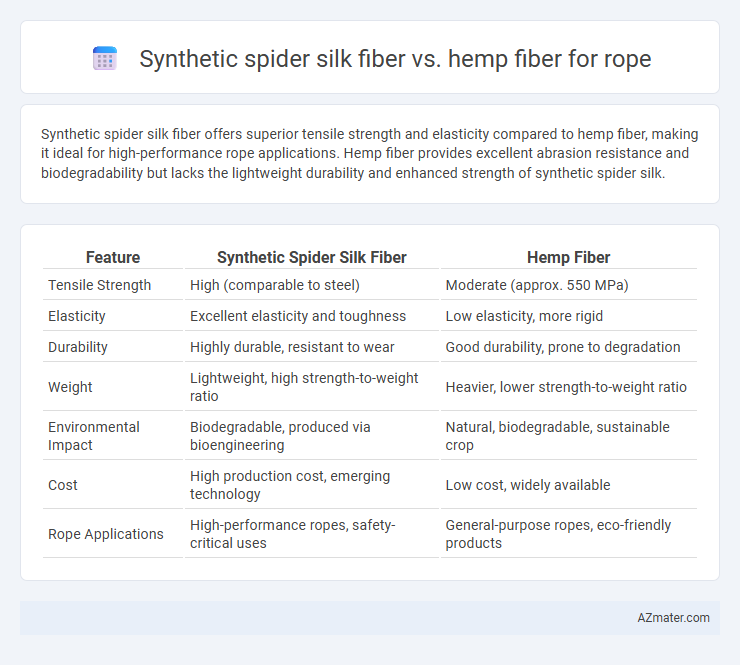Synthetic spider silk fiber offers superior tensile strength and elasticity compared to hemp fiber, making it ideal for high-performance rope applications. Hemp fiber provides excellent abrasion resistance and biodegradability but lacks the lightweight durability and enhanced strength of synthetic spider silk.
Table of Comparison
| Feature | Synthetic Spider Silk Fiber | Hemp Fiber |
|---|---|---|
| Tensile Strength | High (comparable to steel) | Moderate (approx. 550 MPa) |
| Elasticity | Excellent elasticity and toughness | Low elasticity, more rigid |
| Durability | Highly durable, resistant to wear | Good durability, prone to degradation |
| Weight | Lightweight, high strength-to-weight ratio | Heavier, lower strength-to-weight ratio |
| Environmental Impact | Biodegradable, produced via bioengineering | Natural, biodegradable, sustainable crop |
| Cost | High production cost, emerging technology | Low cost, widely available |
| Rope Applications | High-performance ropes, safety-critical uses | General-purpose ropes, eco-friendly products |
Introduction to Synthetic Spider Silk and Hemp Fibers
Synthetic spider silk fiber, engineered through bio-mimicry of natural spider silk proteins, exhibits remarkable tensile strength and elasticity, making it ideal for advanced rope applications requiring durability and lightweight performance. Hemp fiber, derived from the stalks of the Cannabis sativa plant, offers high tensile strength, natural resistance to UV light and mold, and eco-friendly biodegradability, positioning it as a sustainable choice for traditional rope manufacturing. Both fibers present unique material properties that influence rope functionality, with synthetic spider silk excelling in strength-to-weight ratio and hemp providing environmental benefits and cost-effectiveness.
Origins and Production Processes
Synthetic spider silk fiber originates from bioengineered proteins produced through microbial fermentation, mimicking the natural silk proteins spun by spiders, while hemp fiber comes from the stalks of the Cannabis sativa plant, harvested and processed through decortication and retting to extract strong bast fibers. Synthetic spider silk production involves genetically modified organisms like bacteria or yeast to produce spidroin proteins, followed by spinning techniques that replicate spider silk's unique molecular alignment for exceptional strength and elasticity. Hemp fiber production relies on sustainable agricultural practices, mechanical or chemical processing to break down and separate the cellulose-rich fibers, which are then spun into durable rope with moderate strength and biodegradability.
Physical and Mechanical Properties
Synthetic spider silk fiber exhibits exceptional tensile strength up to 1.6 GPa and a Young's modulus around 10 GPa, outperforming hemp fiber, which typically has tensile strength near 550 MPa and a modulus of 30 GPa. Spider silk's remarkable elasticity, with elongation at break reaching 30%, offers superior toughness compared to hemp's lower elongation of 2-4%, making it more resistant to sudden shocks. The lightweight nature and biocompatibility of synthetic spider silk fiber further enhance its suitability for high-performance rope applications demanding durability and flexibility.
Strength and Durability Comparison
Synthetic spider silk fiber exhibits tensile strength up to 1.3 GPa, surpassing hemp fiber's typical range of 0.4 to 0.9 GPa, making it significantly stronger for rope applications. In terms of durability, synthetic spider silk demonstrates excellent resistance to fatigue, UV radiation, and moisture, whereas hemp fibers are prone to degradation from prolonged exposure to water and UV light. These properties position synthetic spider silk as a highly durable and strong material, outperforming traditional hemp fiber in both strength and longevity for rope manufacturing.
Flexibility and Elasticity Differences
Synthetic spider silk fiber exhibits superior flexibility and elasticity compared to hemp fiber, making it ideal for ropes requiring high tensile strength with stretchability. The molecular structure of synthetic spider silk allows it to elongate up to 35% before breaking, whereas hemp fiber typically stretches only around 2-3%. This significant difference in elasticity enhances durability and resistance to dynamic loads in applications like climbing and rescue ropes.
Environmental Impact and Sustainability
Synthetic spider silk fiber, engineered for high tensile strength and biodegradability, offers a promising eco-friendly alternative to traditional materials in rope manufacturing. Hemp fiber is renowned for its rapid growth, low pesticide requirement, and carbon sequestration capabilities, making it a highly sustainable and renewable resource. Comparatively, synthetic spider silk fibers have the potential for lower environmental impact due to minimal water usage and reduced land demand, while hemp fiber supports soil health and biodiversity through its natural cultivation process.
Applications in Rope Manufacturing
Synthetic spider silk fiber offers superior tensile strength, elasticity, and lightweight properties compared to hemp fiber, making it ideal for high-performance rope applications in aerospace and military sectors. Hemp fiber provides excellent durability, natural resistance to UV light and mildew, and cost-effectiveness, preferred in eco-friendly marine and agricultural ropes. Rope manufacturers leverage synthetic spider silk's biomimetic engineering for ultra-strong, shock-absorbing ropes while using hemp fiber for sustainable, biodegradable alternatives.
Cost and Commercial Availability
Synthetic spider silk fiber commands a higher price due to its complex bioengineering process, limiting widespread commercial availability compared to hemp fiber, which is abundant and cost-effective. Hemp fiber benefits from well-established agricultural supply chains, making it a preferred option for affordable, scalable rope production. While synthetic spider silk offers superior strength-to-weight ratios, its current cost and limited production scale restrict its commercial use primarily to specialized applications.
Innovations and Future Prospects
Synthetic spider silk fiber demonstrates exceptional tensile strength and elasticity compared to hemp fiber, driven by bioengineered proteins that mimic natural spider silk properties. Innovations in genetic engineering and polymer science are enhancing production scalability and environmental sustainability, positioning synthetic spider silk as a superior alternative for high-performance ropes. Future prospects include integrating nanotechnology to improve durability and functionality, potentially revolutionizing industries reliant on lightweight, strong, and biodegradable rope materials.
Conclusion: Choosing the Right Fiber for Ropes
Synthetic spider silk fiber offers superior tensile strength and elasticity compared to hemp fiber, making it ideal for high-performance ropes requiring durability and flexibility. Hemp fiber, while less strong, provides excellent abrasion resistance, biodegradability, and cost-effectiveness for everyday rope applications. Selecting the right fiber depends on balancing performance needs with environmental impact and budget constraints.

Infographic: Synthetic spider silk fiber vs Hemp fiber for Rope
 azmater.com
azmater.com